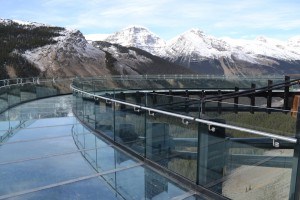
Canada’s national parks are under threat from commercial development and both Jasper and Banff national parks are taking the brunt of it, according to a report published by the Canadian Parks and Wilderness Society (CPAWS).
The scathing report highlights seven commercial projects that have either been approved or are in the pipeline for approval, with six of those projects located in Jasper and Banff.
“With the growing list of projects it’s got to the point where we’re really seeing this as a crisis in our national parks that needs to be stopped,” said Alison Woodley, national director for CPAWS.
“Canadians need to stand up and fight to protect the amazing natural legacy that our national parks represent.”
The report slammed the construction of the Glacier Skywalk, describing it as a “private pay-for-use theme park-like development” and criticized the proposed development of 15 tent cabins at Maligne Lake.
“At the end of the 1990s there was a whole suite of policies and legislative changes that were made to cap commercial development, particularly in the Rocky Mountain National Parks,” said Woodley.
One of those legislative changes included making the ecological integrity of Canada’s national parks a top priority.
To strengthen that mandate, Parks Canada updated Jasper National Park’s management plan which affirmed that no new land would be made available for overnight commercial accommodations outside of the Jasper townsite.
Despite the new management plan, last summer Parks approved all but one of Maligne Tours Ltd.’s development proposals, including the construction of 15 tent cabins that would allow guests to stay overnight on the shores of Maligne Lake. Parks did, however, reject the company’s proposal to build a 66-room hotel.
Weeks after the decision was made, Ecojustice, on behalf of CPAWS and the Jasper Environmental Association, filed a court challenge against Parks to try and quash the possibility of overnight accommodations at the lake.
The Federal Court in Edmonton will hear Ecojustice’s legal challenge Oct. 27 and 28.
“It seems like once every generation, once every 20 years or so, private commercial interests gain a foothold in our parks,” said Woodley.
“In the 1960s and 70s and in the 1990s Canadians stood up and fought hard to stop massive commercial development projects in Banff and won and now 20 years later we’re starting to see a similar trend emerge.”
In an emailed statement, Cathy Jenkins, acting field unit superintendent for Jasper, said Parks is committed to protecting the ecological integrity of all national parks, and that’s why strict development limits are in place to protect Canada’s parks.
“Parks Canada has a rigorous development review and environmental assessment process that ensures all development proposals comply with these limits and that the parks’ ecological integrity is maintained,” she wrote.
She cited the Canada National Parks Act, the Canadian Environmental Assessment Act and parks management plans as key pieces of legislation that guide development in the park.
As well as the developments themselves, the CPAWS report also slammed the government for shortening public consultation periods and ignoring public feedback, stating private interests appear to be taking precedence over the public interest.
Woodley was highly critical of the public consultation process that was carried out prior to approving the expansion of Lake Louise Ski Resort in August.
“The process was completely unacceptable. It was a three-week comment period in the summer to comment on over 250 pages of technical documents,” she said, adding that despite the short period of time, 1,200 people commented on the proposed development.
“Over 90 per cent opposed the development and yet no changes were made.”
Based on the outcome at Lake Louise, CPAWS stated it would be keeping an eye on future development plans put forward by Marmot Basin Ski Area.
In June, Parks approved the first of two long range development plans for the ski area. The first plan focuses largely on the already developed areas of the ski hill, such as expanding the resort’s snow making operations.
The second plan, expected to be published in 2015 or 2016, will likely focus on proposed expansion into areas outside of the ski resort’s current boundaries, and could include the development of ski lifts in the Tres Hombres and Outer Limits areas.
Expansion into these areas will depend on a caribou risk assessment, which has already found that any new development would threaten the Tonquin caribou herd, which is listed as threatened by the federal government.
On the other side of the country, the report was extremely critical of Parks for approving, in principle, the construction of a giant seven-storey statue on the shores of Green Cove in Cape Breton Highlands National Park, pending the outcome of an environmental review.
Known as Mother Canada, the project would also include a large parking lot, gift shop and interpretive centre.
According to CPAWS, the public consultation period for that project lasted only two weeks.
“It’s time for Canadians to stand up and fight for the essence of what our national parks are all about,” said Woodley.
“Our national parks belong to all Canadians from coast to coast to coast. Each and every one of us is a part owner of our national parks. They’re part of the heart and soul of this country, so it’s really important that Canadians are engaged in what happens in our national parks.”
Paul Clarke
[email protected]
